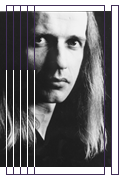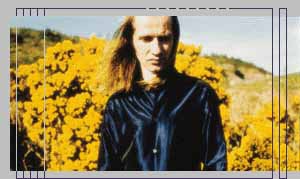An IMN - Irish Music Net article
Published in FolkWorld with friendly permission of the editor
Aisling Gheal
an interview with Iarla O Lionáird
For an overnight sean nós singing sensation Iarla O Lionáird has done a lot and the steps that have lead to 1997's successful solo album Seacht gCoiscéim na Trocaire (Seven Steps to Mercy) on Peter Gabriel's Real World label have been more than seven.

Born in the West Cork gaeltacht area of Cúil Aodha in 1964 he's been steeped in music from an early age. He first performed aged five, and his first recordings, done for the radio, were when he was aged seven. He's won more medals at Feisanna nation-wide than you can shake the proverbial stick at. He presented RTÉ's trad series, The Pure Drop. He's worked as a teacher, a practical application of his B Ed from UCD. He's recorded and performed for Sean Davey, fronting over five-hundred musicians (a thirty-five piece pipe band, three choirs and a full orchestra) for Davey's project The Pilgrim. With accordion player Tony MacMahon he recorded a live album for Gael-Linn, Aislingí Ceoil. He's performed with the touring Faith of Our Fathers series of gigs. He can be found on the River of Sound album and on the Sult recording. He's even found time to forge a modest career in the realm of film and TV production.
"I've tried a lot of different things in my life, a lot of different careers. I was into film and I was into TV production and all that stuff. I never wanted to give in to the idea that all I could do was sing. I'd been told that since I was a kid. But I had to give in to it eventually, because it was still the thing that I found ... I don't know, I just found that I did it better than anything else I did."
Cúil Aodha has long been associated in musical minds with the legendary Sean Ó Riada who is often credited with being the keystone of the revival of interest in traditional music at a time when it was under threat. In the fifties, before Ó Riada, you could be kicked out of a pub like O'Neill's in Suffolk Street for singing sean nós.
 "There's a reservoir there. There was always singing in Cúil Aodha. Ó Riada's influence was profound though, in that he stopped it from evolving in the way that Ireland was evolving in the sixties. His whole purpose was to highlight the local art - and in fact the national art, the traditional arts like music and song. His effect on Cúil Aodha was profound in that he stopped a whole legion of people getting interested in the showband scene, and kept them singing the local songs for another generation. It's quite conceivable that I would not be here now today were it not for that happening"
"There's a reservoir there. There was always singing in Cúil Aodha. Ó Riada's influence was profound though, in that he stopped it from evolving in the way that Ireland was evolving in the sixties. His whole purpose was to highlight the local art - and in fact the national art, the traditional arts like music and song. His effect on Cúil Aodha was profound in that he stopped a whole legion of people getting interested in the showband scene, and kept them singing the local songs for another generation. It's quite conceivable that I would not be here now today were it not for that happening"
Three of Iarla's more recent musical projects came to public attention in 1997. Technogue is a collaboration with producer Ingmar Kiang, and resulted in the release by Lime Records of a single, Abha na Séad, in December. There was the previously mentioned solo album, of which more anon. And there was the considerable prominence given to the Afro Celt Soundsystem, whose 1996 disc, Volume 1 Sound Magic, received quite a few column inches from Those Who Know About These Things.
The Afro Celt project is a collaboration between Scots and Irish Celtic and African musicians, fusing traditional Irish music with African rhythms, on a trip-hop background. The whole project is very much an embodiment of the ideal of Peter Gabriel's Real World label and it was through a letter O Lionáird wrote to Gabriel that his involvement with Afro Celt came about.
"I wrote to Real World and it was the only begging letter I have ever written in my life. It was six pages long and written by hand and it must have been illegible."
 Legible enough though to result in an invitation to one of Gabriel's "Recording Weeks" in his Wiltshire Studio and his subsequent involvement in the Afro Celt project.
Legible enough though to result in an invitation to one of Gabriel's "Recording Weeks" in his Wiltshire Studio and his subsequent involvement in the Afro Celt project.
"That was brilliant. It allowed me to sing sean nós in the setting of contemporary club culture. It's such an intriguing blend, using primary colours to create a picture of sophistication."
The notion of music having colour - and shape - is something Iarla firmly believes in.
"Music has a shape and a colour. It's usually quite simple. The higher the tone the brighter the colour. The shape of it is interesting. Sounds actually make a shape in your mind. And particularly now that you have such an opportunity to manipulate sound in the studio and make sharp shapes and twisting shapes. The mind sees it that way."
The success generated by the Afro Celt project put Iarla's own solo project on hold, but eventually, in early '97 work commenced. The album was produced by Canadian Michael Brooks, ex of Martha and the Muffins, noted composer / producer and sometime collaborator with Brian Eno and Daniel Lanois. There are some influences to be heard on it of fellow Cúil Aodha musician Peadar Ó Riada, son of the late Sean.

"Peadar's a profound influence on me. Has been and will continue to be. He's a visionary, he is the Brian Eno of Ireland, because he is the only person who does things from the ground up. His work's beautiful. He's a sonic innovator, a sound archaeologist, a sound scientist if you like. When I played Michael Brook his albums he was totally enchanted by them. Michael's very like Peadar in a way."
The album is very much a collaboration between Michael and Iarla, mixing O Lionáird's striking voice with ambient sounds recorded in Cúil Aodha, guitar loops and other samples.
"He's one of the first producers I've met who shared my vision, which was not to soften or sentimentalise the music, but draw deeper from the heart - to take what is within and bring it to the surface. Everyone else seems to want to tart up the raw, ancient stuff and make it palatable. Michael, who comes from an experimental rock'n'roll background didn't want to do that and observing this ultra-modern musician getting to grips with a deep, ancient approach was amazing."
What can't be escaped in listening to the disc is the emotion contained within O Lionárd's powerful and striking voice.
"You go into your own space and you emotionalise, using the song, text and music and you give yourself up to that. The traditional sean nós edict would say you should probably adhere to the story and then emotionalise that message. I'm worried sometimes that people perhaps don't experiment enough."
A dark and some might even say morbid album, all the trax on Seacht gCoiscéim are sung as gaelgae. The effect of this for the average listener is that what comes across most is the music. Space and time dictated that the album's sleeve be bereft of liner notes detailing the text of the songs, which in a way adds to the mystique of the music.
"I'm much more interested in musical revelation than lyrical revelation. I do think that you can have revelation using music, otherwise nobody would be at it. I'm much more interested in where will the music take me and the audience, what growth effect it will have when you add it all together."
Not a man to stand still and let the moss grow on him, work on the next album is already in hand, and Iarla is promising something different again.
"The most challenging thing for a solo singer is to work with other people. I'm not just going to croon along. I'm planning to work with Howie B and some Asian trip-hop people to produce an album that says this is the 1990s and I enjoy living in them.
And may we continue to enjoy living in them with him.
 "There's a reservoir there. There was always singing in Cúil Aodha. Ó Riada's influence was profound though, in that he stopped it from evolving in the way that Ireland was evolving in the sixties. His whole purpose was to highlight the local art - and in fact the national art, the traditional arts like music and song. His effect on Cúil Aodha was profound in that he stopped a whole legion of people getting interested in the showband scene, and kept them singing the local songs for another generation. It's quite conceivable that I would not be here now today were it not for that happening"
"There's a reservoir there. There was always singing in Cúil Aodha. Ó Riada's influence was profound though, in that he stopped it from evolving in the way that Ireland was evolving in the sixties. His whole purpose was to highlight the local art - and in fact the national art, the traditional arts like music and song. His effect on Cúil Aodha was profound in that he stopped a whole legion of people getting interested in the showband scene, and kept them singing the local songs for another generation. It's quite conceivable that I would not be here now today were it not for that happening"
